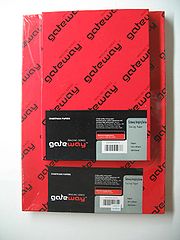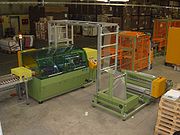
Shrinkwrap
Encyclopedia

Polymer
A polymer is a large molecule composed of repeating structural units. These subunits are typically connected by covalent chemical bonds...
plastic film. When heat is applied it shrinks tightly over whatever it is covering. Heat can be applied with a hand held heat gun
Heat gun
A heat gun is a device used to emit a stream of hot air. They are superficially similar in shape and construction to a hair dryer, though they run at much higher temperatures...
(electric or gas) or the product and film can pass through a heat tunnel on a conveyor.
Composition
The most commonly used shrink wrap is polyolefinPolyolefin
A polyolefin is a polymer produced from a simple olefin as a monomer. For example, polyethylene is the polyolefin produced by polymerizing the olefin ethylene. An equivalent term is polyalkene; this is a more modern term, although polyolefin is still used in the petrochemical industry...
. It is available in a variety of thicknesses, clarities, strengths and shrink ratios. The two primary films can be either crosslinked, or non crosslinked. Other shrink films include PVC
PVC
Polyvinyl chloride is a plastic.PVC may also refer to:*Param Vir Chakra, India's highest military honor*Peripheral venous catheter, a small, flexible tube placed into a peripheral vein in order to administer medication or fluids...
and several other compositions.
Coextrusions and laminations are available for specific mechanical and barrier properties for shrink wrapping food.
Manufacture

Films are stretched when they are warm to orient the molecules from their initial random pattern. Cooling the film sets the film's characteristics until it is reheated: this causes it to shrink back toward its initial dimensions.
Prior to orientation, the molecules of a sheet or tube are randomly intertwined like a bowl of spaghetti. The molecules are coiled and twisted and have no particular alignment. However when a draw force is imposed, the amorphous regions of the chains are straightened and aligned to the direction of orientation. By applying proper cooling, the molecules will be frozen in this state until sufficient heat energy is applied to allow the chains to shrink back. One can visualize this phenomenon by stretching a rubber band and dipping it into liquid nitrogen so as to freeze in the stretched state. The band will remain in this state as long as it is kept at sufficiently cold temperatures. However, when enough heat energy is applied, the rubber band will shrink back to its original relaxed state.
Orientation on a commercial scale can be achieved using either of two processes: a tenterframe or a bubble process. Tenterframe technology is used to produce a variety of “heat-set” products, with BOPP being the most common (heat-setting is a process whereby a film is reheated in a constrained state such that the shrink properties are destroyed).
The second commercial process is the bubble process, sometimes referred to as the tubular process. In this process, a primary tube is produced by either blowing or casting the tube onto an external or internal mandrel, respectively. It is common to use water to help cool the primary tube at this point. After the primary tube has been cooled, it is then reheated and inflated into a second bubble using air much like a balloon is blown. Upon inflation, the tube is oriented in both directions simultaneously.
The family of shrink films has broadened over the years with many multilayer constructions being sold today. Shrink film attributes include shrink, sealability, optics, toughness, and slip. With regard to shrink properties, there are onset temperature, free shrink, shrink force, shrink temperature range, memory, and overall package appearance.
Use
Shrink wrap is applied over or around the intended item, often by automated equipment. It is then heated by a heat gunHeat gun
A heat gun is a device used to emit a stream of hot air. They are superficially similar in shape and construction to a hair dryer, though they run at much higher temperatures...
or sent through a shrink tunnel
Shrink tunnel
A Shrink tunnel or Heat tunnel is a heated tunnel mounted over or around a conveyor system. Items such as packaging, have shrink film loosely applied; with heat, the film shrinks to fit snugly around the wrapped object.-Uses:* Shrink labels...
or oven
Oven
An oven is a thermally insulated chamber used for the heating, baking or drying of a substance. It is most commonly used for cooking. Kilns, and furnaces are special-purpose ovens...
for shrinking.
Shrink wrap can be supplied in several forms. Flat rollstock can be wrapped around a product, often with heat sealing to tack the film together. Centerfolded film is supplied on a roll with the plastic is folded in half: product is placed in the center portion, the remaining three edges are sealed to form a bag, and the package then heated which causes the bag to shrink and conform to the product placed in the bag. Pre-formed shrink bags plastic bags are used with one end open: the product is placed in the bag, sealed, and sent for heat shrinking.
Shrink wrap can be used to wrap buildings. It can wrap roofs after hurricanes, earthquakes, tornadoes and other disasters. Shrink wrap can be used for environmental containments to facilitate safe removal of asbestos, lead and other hazards.
Shrink wrap is sometimes used to wrap up books, especially adult-oriented ones and certain comics and manga
Manga
Manga is the Japanese word for "comics" and consists of comics and print cartoons . In the West, the term "manga" has been appropriated to refer specifically to comics created in Japan, or by Japanese authors, in the Japanese language and conforming to the style developed in Japan in the late 19th...
, mainly to prevent them from being read by minors.
Software on carriers such as CDs or DVDs are often sold in boxes that are packaged in shrink wrap. The licenses of such software are typically put inside the boxes, making it impossible to read them before purchasing. This has raised questions about the validity of such shrink wrap licenses
Shrink wrap contract
Shrink wrap contracts are license agreements or other terms and conditions of a contractual nature which can only be read and accepted by the consumer after opening the product. The term describes the shrinkwrap plastic wrapping used to coat software boxes, though these contracts are not limited...
.
Shrink wrap is commonly used as an overwrap on many types of packaging, including carton
Carton
Carton is the name of certain types of containers typically made from paperboard which is also sometimes known as cardboard. Many types of cartons are used in packaging. Sometimes a carton is also called a box.-Folding cartons:...
s, box
Box
Box describes a variety of containers and receptacles for permanent use as storage, or for temporary use often for transporting contents. The word derives from the Greek πύξος , "box, boxwood"....
es, beverage can
Can
Can may refer to:-Container:* Aluminum can* Steel can, an airtight tinplate container for storing food and other predominantly liquid products* Beverage can, a can designed to hold a single serving of a beverage* Oil can...
s and pallet
Pallet
A pallet , sometimes called a skid, is a flat transport structure that supports goods in a stable fashion while being lifted by a forklift, pallet jack, front loader or other jacking device. A pallet is the structural foundation of a unit load which allows handling and storage efficiencies...
loads. A variety of products may be enclosed in shrink wrap to stabilize the products, unitize them, keep them clean or add tamper resistance. It can be the primary covering for some foods such as cheese, meats,vegetables and plants. Heat-shrink tubing
Heat-shrink tubing
Heat shrink tubing is a mechanically expanded extruded plastic tube ordinarily made of nylon or polyolefin, which shrinks when heated in an effort to return to the original relaxed diameter as when it was extruded...
is used to seal electric wiring.
Shrink bands are applied over parts of packages for tamper resistance
Tamper resistance
Tamper resistance is resistance to tampering by either the normal users of a product, package, or system or others with physical access to it. There are many reasons for employing tamper resistance....
or labels. It can also combine two packages or parts.
Shrink wrap is also commonly used within more industrial applications using a heavier weight shrink film. The principles remain the same with a heat shrinking process using a hand held heat gun. The following shrink wrap applications are becoming more widely used and accepted:
- Industrial shrink wrap containment of large plant equipment/components,
- Scaffold wrap containment of buildings/bridges,
- Building temporary shrink wrap structures for storage or other business operational uses,
- Marine shrink wrapping of boats and other vehicles,
- Shrink wrapping of palletized freight
- Disaster contingency and relief projects such as damaged buildings/roofs.
See also
- Shrink wrap contractShrink wrap contractShrink wrap contracts are license agreements or other terms and conditions of a contractual nature which can only be read and accepted by the consumer after opening the product. The term describes the shrinkwrap plastic wrapping used to coat software boxes, though these contracts are not limited...
- Plastic wrapPlastic wrapPlastic wrap, cling film , cling wrap or food wrap, is a thin plastic film typically used for sealing food items in containers to keep them fresh over a longer period of time...
- Stretch wrapStretch wrapStretch wrap or stretch film is a highly stretchable plastic film that is wrapped around items. The elastic recovery keeps the items tightly bound...
- PLA filmPLA filmPLA film is an advanced type of packaging for application to the containers of soft drinks and dairy products. It can be a film overwrap and is heat-shrinkable...
- Multi-packMulti-packA Multi-pack is packaging that combines or holds multiple items or smaller packages.-Functions:Multi-packs can be used to:* Combine several items for a larger unit of sale, often with a reduced individual cost* Provide convenience to carry several items...
- Overwrap
- Window insulation filmWindow insulation filmWindow insulation film is a plastic film which can be applied to glass windows to reduce heat transfer. There are two types in common use designed to reduce heat flow via radiation and convection respectively.- Solar control film :...
Further reading
- D882 Standard Test Method for Tensile Properties of Thin Plastic Sheeting
- D883 Standard Terminology Relating to Plastics
- D1204 Standard Test Method for Linear Dimensional Changes of Nonrigid Thermoplastic Sheeting or Film at Elevated Temperature
- D1894 Standard Test Method for Static and Kinetic Coefficients of Friction of Plastic Film and Sheeting
- D1922 Standard Test Method for Propagation Tear Resistance of Plastic Film and Thin Sheeting by Pendulum Method
- D2732 Standard Test Method for Unrestrained Linear Thermal Shrinkage of Plastic Film and Sheeting
- D2838 Standard Test Method for Shrink Tension and Orientation Release Stress of Plastic Film and Thin Sheeting

